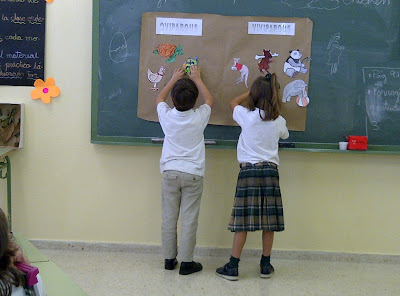To conclude my ELT methodology blog, I am going to do an overall self-evaluation of my learning process and outcomes during the semester and some reflections on the course.
To begin, I want to say that with this subject I have learned lots of new contents and information that I hadn't heard about before doing this course. So with these lessons I have developed more and more my learning about teaching English at primary school.
I also want to remark that this course has been very useful for some reasons: the first one is that I have learned a big amount of vocabulary related with ELT that would be very valuable for my future as an English teacher.
The second one is the fact that we have been able to learn and design a CLIL, which I could see last year in my school of practicum, but I didn't know very well how it worked and how to design it.
In the third place, now I know the importance of the internet education tools, like symbaloo or apps. Also, building my PLE and seeing my peers' has been an opportunity to collect in my PLE a great number of them that will be very fruitful as a teacher because they help the students in their own learning process. So, according to nowadays technologies, we should become networked teachers to be able to use and learn from peers on the net and to give our students the possibility of learning by doing with apps.
The fourth reason is that now I know how important is to create child-centered classroom, to promote students getting involved on their own knowledge to become autonomous learners.
The fifth important content I have acquired is the importance of the home-school connection. As teachers, if we connect the two most important worlds of our pupils (home and school), they can get lots of benefits. Parents feel proud and children can show and practice their learning at home, so they are always learning. And we should try to connect with the families with all the different activities we have learned during the course like letters home or muffins for mums.
The next important point is related to differentiation, as teachers we have to bear in mind that every student is different, with different backgrounds, ideas, previous knowledge or interests. This is why we must teach them attending to these differences, creating respectful tasks, doing flexible groups and teaching up. Moreover, it is highly valued to remember that “we learn the way we are smart” (Gardner), so as future teachers we will have to identify every students’ learning strategies, to teach in the seven different ways and try to develop the other intelligences choosing activities with different learning styles.
Moreover, we have to take into account that is so necessary to think deeply on how to manage our classroom. As we have learned, teachers should reflect on organisational, curriculum and social issues to manage their own classroom in order to guarante a successful learning environment.
I also have improved my pronunciation during this course because I have been talking English with classmates and the teacher has been always correcting us and moreover, I have learned a lot preparing the CLIL unit and the different presentations we have done in class.
As for the writing, it has also been very useful to write my blog since I have learned a lot of vocabulary by searching for new words or expressions in dictionaries or in wordreference.
In conclusion, I have developed my learning on ELT methodology during this course by doing all the different and interesting tasks. Personally, doing this blog has been a useful tool to reflect on my own learning process, to share my ideas with peers and to read different opinions in other blogs. I hope I can keep on being a networked teacher now I have my PLE, and it would be useful for my future as a teachers because I would be able to use all what I have learned with my pupils.










































